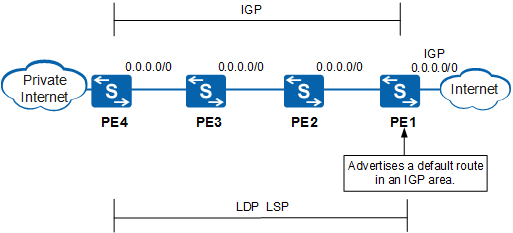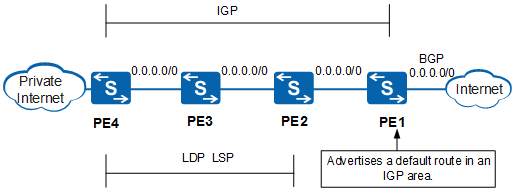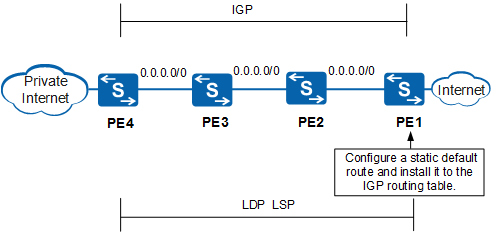(Optional) Enabling a Device to Assign a Label to a Default IGP Route
Context
A device can use MPLS to assign a label to a default IGP route in independent mode. An LSP can be established using the default route.
A device assigns a label to a default IGP route in any of the following scenarios:
Scenario 1
In Figure 1, MPLS LDP is enabled on each PE, and an IGP is run between PEs. PE1 and its downstream devices are in the same IGP area. The PEs can learn the default IGP route. If PE1 and its downstream device are in different IGP areas, PE1 receives a default IGP route through the Internet and advertises it in each IGP area to which each PE belongs. PE2, PE3, and PE4 then receive the default IGP route. After each PE is enabled to assign a label to the default IGP route, an LSP is established using the default route over the path PE4 > PE3 > PE2 > PE1. When PE4 sends traffic to the Internet and no matching specific route is found, PE4 sends the traffic over the route and through the LSP. The traffic is forwarded to PE1. Ultimately, the traffic reaches the Internet.
Scenario 2
In Figure 2, MPLS LDP is enabled on each PE, and an IGP is run between PEs. PE1 receives a default BGP route through the Internet and advertises the default route within the IGP area. PE2, PE3, and PE4 receive the default IGP route. After each PE is enabled to assign a label to the default route, an LSP over the default route is established and passes through PE4, PE3, and PE2. PE1 does not assign a label to the default route that is a BGP route. When PE4 sends traffic to the Internet and no matching specific route is found, PE4 sends the traffic over the default route and through the LSP. The traffic is forwarded to PE2 over the LSP, and PE2 forwards the traffic over IP to PE1. The traffic then reaches the Internet.
Scenario 3
In Figure 3, MPLS LDP is enabled on each PE, and an IGP is run between PEs. A static default route is configured on PE1 and is imported to the IGP. PE2, PE3, and PE4 receive the default route. After each PE is enabled to assign a label to the default IGP route, an LSP is established using the default route over the path PE4 > PE3 > PE2 > PE1. After PE4 sends traffic to the Internet and no matching specific route is found, the traffic enters the LSP over the route and is forwarded to PE1. Ultimately, the traffic reaches the Internet.


